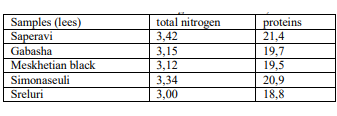Perspectives of Wine Lees Application in Poultry Farming
Keywords:
red wine, by-products, wine lees, proteins, protein concentrateAbstract
Almost all industries imply production not only the target products but the industrial waste materials as well, which are received during the processing of multicomponent raw materials. Industrial wastes may contain compounds which can be converted into useful products after mechanical, thermal or chemical treatment. Thus, any waste may become a useful raw material to receive different products. That is why industrial wastes should be considered as a resource of secondary material. In our experiments we have used one of the secondary products of winemaking - red wine lees, which are rich in biologically active substances. A protein concentrate prepared from the lees was tested in poultry farming to increase productivity.
References
A. Teixeira, N. Baenas, R. Dominguez-Perles, A. Barros, E. Rosa, D.A.Moreno, C. Garcia-Viguera, “Natural Bioactive Compounds from Winery By-Products as Health Promoters: A Review,” International Journal of Molecular Sciences, Vol. 15, Issue 9, pp. 15638-15678, 2014. doi: 10.3390/ijms150915638.
E. Fiore, B. Stabelini, P. Tamborrini, “A Systemic Design Approach Applied to Rice and Wine Value Chains. The Case of the InnovaEcoFood Project in Piedmont{Italy)”, Publisher MDPI, Sustainability, Vol.12, Issue 21, p.9272, 2020. doi.org/10.3390/su12219272
E.Kalli, I. Lappa, P. Bouchagier, P.A. Tarantilis, E. Skotti, “Novel application and industrial exploitation of winery by-products,” Bioresources and Bioprocessing, Vol.5, No 46. 2018. https://doi.org/10.1186/s40643-018-0232-6.
M. Oliveira, E. Duarte, “Integrated approach to winery waste: Waste generation and data consolidation. Front. Environ,” Frontiers of Environmental Science & Engineering,. Vol.10, 168–176, 2016, doi:10.1007/s11783-014-0693-6
J.A. Pérez-Serradilla, M.D. Luque de Castro, “Role of lees in wine production,” J. Food Chem., Vol. 111, Issue 2, pp. 447–456. 2008
M.A. Bustamante, R. Moral, C. Paredes, A. Pe?rez Espinosa, J. Moreno Caselles, et al. “Agrochemical characterisation of the solid byproducts and residues from the winery and distillery industry,” J. Waste Management, Vol. 28, Issue 2, pp. 372-380. 2008.
M. Teixeira Barcia, P.Becker Pertuzatti, S. Gómez-Alonso, H. Teixeira Godoy, I. Hermosín-Gutiérrez, “Phenolic composition of grape and winemaking by-products of Brazilian hybrid cultivars BRS Violeta and BRS Lorena,” J. Food Chem. 159, pp. 95–105, 2014.
J.F. García Martín, L. Guillemet, C. Feng, D.W. Sun, “Cell viability and proteins release during ultrasound-assisted yeast lysis of light lees in model wine”. J. Food Chem. 141, pp. 934–939, 2013.
R. Devesa-Rey, X. Vecino, J.L. Varela-Alende, A.B. Moldes, “Valorization of winery waste vs. the costs of not recycling”. J. Waste Management, Vol. 31, Issue 11, pp. 2327-2335. 2011.
C. Dimou, N. Kopsahelis, A. Papadaki, S. Papanikolaou, I.K. Kookos, I. Mandala, A.A. Koutinas, “Wine lees valorization: Biorefinery development including production of a generic fermentation feedstock employed for poly(3-hydroxybutyrate) synthesis,” J. Food Res. Int., 73, pp. 81–87. 2015.
M.Tsukada, H. Sheng, T. Kamachi, Y.Niwano, “Microbicidal action of photoirradiated aqueous extracts from wine lees,” J. Food Sci. Technol. 53, pp. 3020–3027. 2016.
M. Varisco, D. Zufferey, A. Ruggi, O. Mamula, “Syntesis of hydrophilic and hybrofobic carbon quantum dots from waste of wine fermentation,” ?J. Royal Society Open Science, Vol. 4, Issue 12, pp. 3538-3553. 2017.
P. Sancho-Galan, A. Amores-Arrocha, A. Jimenes-Cantizano, V. Palacios, “Re-utilization of winemaking lees as a new food ingredient,” Cadiz, Spain: science, p. 780, 2018.
P. Ribereau-Gayon, D. Dubourdieu, B. Doneche, A. Lonvaud, “Handbook of Enology Volume 1 The Microbiology of Wine and Vinifications 2nd Edition” Publisher: John Wiley & Sons, England, p. 89, 2006.
E.C. Sousa, A E.C. Sousa, A.M.A. Uchoa Thomaz, J.O.B. Carioca, S.M. Morais, A. Lima, “Chemical composition, fatty acid profile and bioactive compounds of guava seeds,” J. Food Science and Technology, Vol. 34, Issue 1, pp. 135-142, 2014.
P. Ribereau-Gayon, D. Dubourdieu, B. Doneche, A. Lonvaud, “Handbook of Enology Volume 1 The Microbiology of Wine and Vinifications 2nd Edition” Publisher: John Wiley & Sons, England, pp. 85-87, 2006.

Downloads
Published
How to Cite
Issue
Section
License

This work is licensed under a Creative Commons Attribution 4.0 International License.
Authors contributing to this journal agree to publish their articles under the Creative Commons Attribution 4.0 International License, allowing third parties to share their work (copy, distribute, transmit) and to adapt it, under the condition that the authors are given credit and that in the event of reuse or distribution, the terms of this license are made clear.





